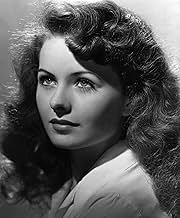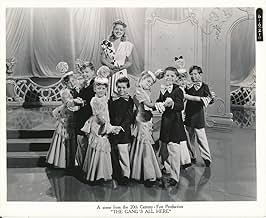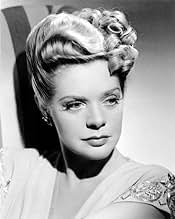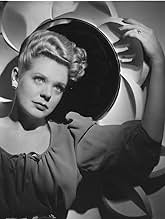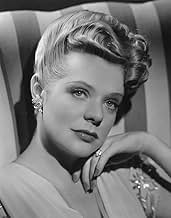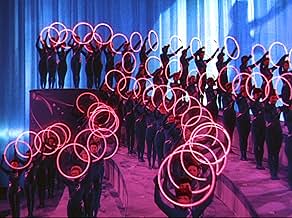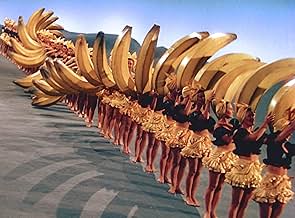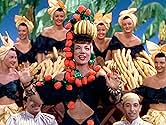IMDb RATING
6.6/10
2.2K
YOUR RATING
A soldier falls for a chorus girl and then experiences trouble when he is posted to the Pacific.A soldier falls for a chorus girl and then experiences trouble when he is posted to the Pacific.A soldier falls for a chorus girl and then experiences trouble when he is posted to the Pacific.
- Nominated for 1 Oscar
- 2 wins & 1 nomination total
Benny Goodman and His Orchestra
- Benny Goodman's Orchestra
- (as Benny Goodman Orchestra)
Don Anderson
- Club New Yorker Patron
- (uncredited)
Leon Belasco
- Waiter
- (uncredited)
Brooks Benedict
- Club New Yorker Patron
- (uncredited)
Lee Bennett
- Club New Yorker Patron
- (uncredited)
William A. Boardway
- Club New Yorker Patron
- (uncredited)
Featured reviews
"The Gang's All Here" is just pure entertainment in the old-school musical style (before Oklahoma!). There's essentially no plot, and what story there is, is full of plot-holes. It's propaganda dressed up in a musical. Don't get negative about this; music and dancing predominate and, of course, the cause is good. Made during WWII it almost subliminally reinforces home front practices during wartime, such as buying war bonds, and staying true to your man in uniform. A lot of this is probably lost to most viewers fifty years later. But think about it, and remember that when this movie was made, the Allied victory was not a sure thing.
And what about the music and dancing? Carmen Miranda in her tutti-frutti hat. Benny Goodman's swing band. Alice Faye. Busby Berkeley. If these people mean any thing to you, they are here in fine form.
And what about the music and dancing? Carmen Miranda in her tutti-frutti hat. Benny Goodman's swing band. Alice Faye. Busby Berkeley. If these people mean any thing to you, they are here in fine form.
... from 20th Century Fox and director Busby Berkeley. The meager plot concerns Army sergeant on leave Andy Mason (James Ellison) who falls for nightclub performer Edie Allen (Alice Faye). The only problem is that Andy's already engaged to Vivian Potter (Sheila Ryan). Edie's flamboyant friend and co-worker Dorita (Carmen Miranda) tries to help, to mixed results. Also featuring Eugene Pallette, Edward Everett Horton, Phil Baker, Charlotte Greenwood, Tony De Marco, Dave Willock, Frank Faylen, June Haver and Jeanne Crain in their debuts, and Benny Goodman and His Orchestra.
The plot is naturally secondary to the musical numbers, several of which are bizarre, most notably "The Lady in the Tutti Frutti Hat", featuring chorus girls running around with giant bananas. Berkeley's camera moves around, under and above the action, shattering the pretense that these numbers are designed for a nightclub or theatrical audience, taking them strictly into the realm of cinema. The costumes are also eye-popping, even those worn in the non-musical scenes, and Miranda wears an assortment of outlandish hats. This marked the end of Alice Faye's star period. She had a cameo in the following year's Four Jills in a Jeep, and then a non-musical part in 1945's Fallen Angel, before entering into screen retirement for 17 years. The movie earned an Oscar nomination for Best Color Art Direction.
The plot is naturally secondary to the musical numbers, several of which are bizarre, most notably "The Lady in the Tutti Frutti Hat", featuring chorus girls running around with giant bananas. Berkeley's camera moves around, under and above the action, shattering the pretense that these numbers are designed for a nightclub or theatrical audience, taking them strictly into the realm of cinema. The costumes are also eye-popping, even those worn in the non-musical scenes, and Miranda wears an assortment of outlandish hats. This marked the end of Alice Faye's star period. She had a cameo in the following year's Four Jills in a Jeep, and then a non-musical part in 1945's Fallen Angel, before entering into screen retirement for 17 years. The movie earned an Oscar nomination for Best Color Art Direction.
Something between a fever-dream and a screwball comedy, THE GANG'S ALL HERE is the Fox Musical at its most extravagant. With everthing from Charlotte Greenwood doing her trademarked high-kick routine to Carmen Miranda in a ten-story banana headdress, there's never a dull moment (that might let you concentrate too closely on the plot, which can most charitably be described as serviceable). The picture is a carnival of character bits, ridiculous shtick, and mind-boggling transitions. Edward Everett Horton gets covered with Carmen's lipstick and claims it's ketchup -- "Yes, and from a Brazilian tomato!" ripostes his wife (Greenwood, who really is terrific here). Eugene Pallette growls "Don't be a square from Delaware!" when he wants his pal Horton to get hep and join in the latest dance sensation. A New York nightclub has a stage large enough for what looks like all of a tropical island (for Carmen's immortal "Lady in the Tutti-Frutti Hat" number, truly a Freudian nightmare), and a number set in a Westchester backyard features more trick fountains than two Esther Williams epics.
In the end, it all just stops, with a 30-second plot resolution ("oh, yes, didn't I tell you? He's loved you all along!" or some such) in order to make room for the finale, the most dizzying number yet: a paean to the polka-dot (featuring Alice Faye's most effortful emoting ever on the line "...But the Polka Dot...Lives...On!") that segues into a ballet featuring neon hoops, vast rolling dots, kaleidoscopic trick photography, and, finally, an endearingly primitive blue-curtain effect that shows the heads of all the principals (and hundreds of chorus girls) bouncing along to a reprise of the hit ballad "A Journey to a Star." Well, THE GANG'S ALL HERE may not be quite that, but it's certainly a journey into a different era in filmmaking.
In the end, it all just stops, with a 30-second plot resolution ("oh, yes, didn't I tell you? He's loved you all along!" or some such) in order to make room for the finale, the most dizzying number yet: a paean to the polka-dot (featuring Alice Faye's most effortful emoting ever on the line "...But the Polka Dot...Lives...On!") that segues into a ballet featuring neon hoops, vast rolling dots, kaleidoscopic trick photography, and, finally, an endearingly primitive blue-curtain effect that shows the heads of all the principals (and hundreds of chorus girls) bouncing along to a reprise of the hit ballad "A Journey to a Star." Well, THE GANG'S ALL HERE may not be quite that, but it's certainly a journey into a different era in filmmaking.
There are films whose plots are much worse. At least this film has funny moments with Charlotte Greenwood and whenever Carmen Miranda is on the screen.
But this film is a showcase for the two sequences choreographed by Busby Berkeley. Much has been written about them, but watching them never ceases to stimulate and amaze my senses. Berkeley's sense of space is so elastic -- you feel as if he could pan and zoom through miles of space and fill it with people, trees, bananas, anything! I don't think any of his Warner Bros. films used the zoom camera with as much daring (supposedly Carmen Miranda almost got knocked off the painted donkey during rehearsals of "The Lady in the Tutti-Frutti Hat").
What is so special for me in these dance sequences is that the images and music are so well-constructed that you loose interest in following the plot and just revel and enjoy the images. People cease being human forms and become elements of color on a painted canvas, and then resume being human once again. It's all incredibly magical and more abstract than Berkeley had been or was able to achieve in the future. Stunning!
But this film is a showcase for the two sequences choreographed by Busby Berkeley. Much has been written about them, but watching them never ceases to stimulate and amaze my senses. Berkeley's sense of space is so elastic -- you feel as if he could pan and zoom through miles of space and fill it with people, trees, bananas, anything! I don't think any of his Warner Bros. films used the zoom camera with as much daring (supposedly Carmen Miranda almost got knocked off the painted donkey during rehearsals of "The Lady in the Tutti-Frutti Hat").
What is so special for me in these dance sequences is that the images and music are so well-constructed that you loose interest in following the plot and just revel and enjoy the images. People cease being human forms and become elements of color on a painted canvas, and then resume being human once again. It's all incredibly magical and more abstract than Berkeley had been or was able to achieve in the future. Stunning!
No doubt about it, the movie's a cast of characters collected in someone's goofy heaven—Carmen Miranda, Busby Berkeley, and Edward Everett Horton, all together in one padded cell. Throw in leggy Charlotte Greenwood and froggy Eugene Palette, and there's enough colorful types for ten musicals. Aside from the conventional plot, this 1943 trip to bizzaroland doesn't disappoint for sheer wackiness.
Of course, there's Miranda's infamous arching bananas replete with the recumbent girls, all of which could have sent Dr. Freud into terminal overload. Really, how the carnally obsessed Berkeley managed to stay this side of the censor is still puzzling. And catch that final number with the disembodied heads and Palette croaking out a song. I'm just wondering what Berkeley's dreams were like. They couldn't be any weirder than what's there on the screen.
Then there's the top of Miranda's head sporting more pointy architecture than the Manhattan skyline. And catch her wardrobe—somewhere there's a dozen circus clowns without their costumes. After that, add a few lines of her hilariously fractured English, and she's a whole wonderful show in herself. Too bad her personal life was apparently so unhappy.
Great color photography, along with a soulful Alice Faye. Even the pretty much unknown James Ellison seems a good stand-in for the boys in uniform. No doubt about it, Hollywood knew how to concoct lively and engaging wartime shows. But just as importantly, these concoctions still entertain decades later, even with an inspired lunatic like Busby Berkeley in charge.
Of course, there's Miranda's infamous arching bananas replete with the recumbent girls, all of which could have sent Dr. Freud into terminal overload. Really, how the carnally obsessed Berkeley managed to stay this side of the censor is still puzzling. And catch that final number with the disembodied heads and Palette croaking out a song. I'm just wondering what Berkeley's dreams were like. They couldn't be any weirder than what's there on the screen.
Then there's the top of Miranda's head sporting more pointy architecture than the Manhattan skyline. And catch her wardrobe—somewhere there's a dozen circus clowns without their costumes. After that, add a few lines of her hilariously fractured English, and she's a whole wonderful show in herself. Too bad her personal life was apparently so unhappy.
Great color photography, along with a soulful Alice Faye. Even the pretty much unknown James Ellison seems a good stand-in for the boys in uniform. No doubt about it, Hollywood knew how to concoct lively and engaging wartime shows. But just as importantly, these concoctions still entertain decades later, even with an inspired lunatic like Busby Berkeley in charge.
Did you know
- TriviaThe production number "The Lady In The Tutti-Frutti Hat" ran into problems with the censors. The Hayes office at first considered the way the gigantic bananas were held in front of the dancers as being too "phallic". The problem was resolved by having the dancers hold the bananas at waist level rather than at hip level.
- GoofsIncorrectly regarded as goof: As the passengers disembark the ship within the first 3 minutes of the film, a series of mechanical-looking large shadows can be easily seen moving across the painted backdrop of buildings intended to be far in the distance. This is actually a stage set of a musical production, thus not filmed as a real scene.
- Quotes
Phil Baker: Oh, Dorita, you remember Mr. Potter and Mr. Mason.
Dorita: Ah! I remember Mr. Potty. You are here to kick up some more heels, huh?
Peyton Potter: No!
Phil Baker: Mr. Potter wants you to come to his house this weekend.
Dorita: Ah-ah-ah, you naughty boy. You are what they call a fast-work man, yes?
- ConnectionsEdited into Myra Breckinridge (1970)
- SoundtracksHail! Hail! The Gang's All Here!
(uncredited)
Music by Theodore Morse and Arthur Sullivan
Lyrics by Dolly Morse (as D.A. Esrom)
Sung by a chorus during the opening credits
- How long is The Gang's All Here?Powered by Alexa
Details
- Release date
- Country of origin
- Languages
- Also known as
- The Gang's All Here
- Filming locations
- Production company
- See more company credits at IMDbPro
- Runtime
- 1h 43m(103 min)
- Color
- Aspect ratio
- 1.33 : 1
Contribute to this page
Suggest an edit or add missing content


